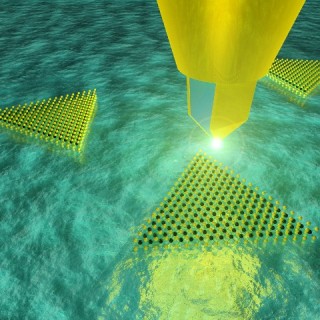Scientists from the Lawrence Berkeley National Laboratory (Berkeley Lab) of the US Department of Energy have successfully performed a molecular-level analysis on the impact of illumination on 2D semiconductors using an innovative nano-optical probe called the Campanile probe.
 With the Campanile probe, optical excitation and collection are spatially confined to the nano-sized gap at the apex of the tip, which is scanned over the sample, recording a full emission spectrum at each position.
With the Campanile probe, optical excitation and collection are spatially confined to the nano-sized gap at the apex of the tip, which is scanned over the sample, recording a full emission spectrum at each position.
The research team performed its experiments at the Molecular Foundry, a DOE Office of Science User Facility. Using the novel probe, the team was able to arrive at some unexpected discoveries about molybdenum disulfide. The compound belongs to a semiconductor family known as transition metal dichalcogenides (TMDCs). The optoelectronic properties of TMDCs are highly promising for future photonic and nanoelectronic devices.
“The Campanile probe’s remarkable resolution enabled us to identify significant nanoscale optoelectronic heterogeneity in the interior regions of monolayer crystals of molybdenum disulfide, and an unexpected, approximately 300 nanometer wide, energetically disordered edge region,” says James Schuck, a staff scientist with Berkeley Lab’s Materials Sciences Division.
Schuck was the leader of this study as well as of the team that developed the Campanile probe, which was honored with the R&D 100 Award in 2013 for integrating the benefits of scan or probe microscopy and optical spectroscopy.
“This disordered edge region, which has never been seen before, could be extremely important for any devices in which one wants to make electrical contacts,” Schuck says. “It might also prove critical to photocatalytic and nonlinear optical conversion applications.”
Schuck, director of the Imaging and Manipulation of Nanostructures Facility at the Molecular Foundry, is the corresponding author of a paper which details this study in the journal, Nature Communications. The paper is titled “Visualizing nanoscale excitonic relaxation properties of disordered edges and grain boundaries in monolayer molybdenum disulfide.” Wei Bao and Nicholas Borys were the co-lead authors.
2D-TMDC competes with graphene as a possible successor to silicon for use in next generation of high-speed electronics. 2D-TMDC has a thickness of just one molecule, and features very high energy efficiencies. It has the capability of carrying very high current densities compared to silicon.
The performance of these materials, experimentally discovered in 2010, has not been satisfactory when compared to theoretical expectations due to lack of information about the 2M-TMDC excitonic and other characteristics at the nanoscale. Excitons are bound pairs of excited holes and electrons that allow the functioning of semiconductors in devices.
Shuck stated:
The poor understanding of 2D-TMDC excitonic and other properties at the nanoscale is rooted in large part to the existing constraints on nanospectroscopic imaging. With our Campanile probe, we overcome nearly all previous limitations of near-field microscopy and are able to map critical chemical and optical properties and processes at their native length scales.
The Campanile probe was named after the historical “Campanile” clock tower in the campus of the University of California, Berkeley. The probe features a four-sided tapered microscopic tip mounted at the tip of an optical fiber.
Two of the sides of the Campanile probe are gold-coated, and the gap between the two gold layers is just a few nanometers at the tip. Since it features a tapered design, the Campanile probe channels light of all wavelengths into an improved field at the apex of the tip. The resolution is decided based on the size of the separation between the gold layers, and this can be less than the diffraction optical limit.
In their latest research, Schuck, Bao, Borys and their co-authors deployed the Campanile probe for spectroscopically mapping nanoscale excited-state/relaxation processes in monolayer molybdenum disulfide crystals that were grown using chemical vapor deposition (CVD). Molybdenum disulfide is a 2D semiconductor featuring high electrical conductance, that is almost as good as graphene. However, unlike graphene, it possesses natural energy bandgaps. This implies that switching off its conductance is possible.
“Our study revealed significant nanoscale optoelectronic heterogeneity and allowed us to quantify exciton-quenching phenomena at crystal grain boundaries,” Schuck said. “The discovery of the disordered edge region constitutes a paradigm shift from the idea that only a 1D metallic edge state is responsible for all the edge-related physics and photochemistry being observed in 2D-TMDCs. What’s happening at the edges of 2D-TMDC crystals is clearly more complicated than that. There’s a mesoscopic disordered region that likely dominates most transport, nonlinear optical, and photocatalytic behavior near the edges of CVD-grown 2D-TMDCs.”
Schuck and his colleagues also ascertained that the disordered edge region in molybdenum disulfide crystals possesses a sulfur deficiency, which indicates the suitability of this 2D-TMDC for future optoelectronic applications.
“Less sulfur means more free electrons are present in that edge region, which could lead to enhanced non-radiative recombination,” Schuck says. “Enhanced non-radiative recombination means that excitons created near a sulfur vacancy would live for a much shorter period of time.”
Schuck and his team are next aiming to analyze the electronic and excitonic characteristics that may occur, as well as the formation of quantum wells and p-n junctions while connecting two contrasting types of TMDCs.
“We are also combining 2D-TMDC materials with so-called meta surfaces for controlling and manipulating the valley states and circular emitters that exist within these systems, as well as exploring localized quantum states that could act as near-ideal single-photon emitters and quantum-entangled Qubit states,” Schuck says.
In addition to Schuck, Bao, Borys and Weber-Bargioni, other co-authors of the Nature Communications paper are Changhyun Ko, Joonki Suh, Wen Fan, Andrew Thron, Yingjie Zhang, Alexander Buyanin, Jie Zhang, Stefano Cabrini, Paul Ashby, Alexander Weber-Bargioni, Sefaattin Tongay, Shaul Aloni, Frank Ogletree, Junqiao Wu and Miquel Salmeron.
The DOE Office of Science supported the research.